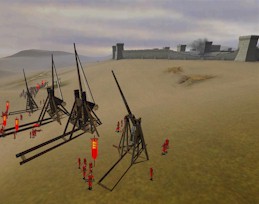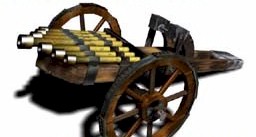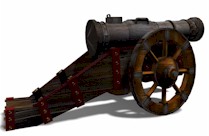
 |
|
SIEGE WARFARE |
| INTRODUCTION |
 |
One of Shogun's few weaknesses and conversely Medievals
greatest single innovation, is the game's castle battles. As well as
towering stone keeps and forbidding ramparts, the whole lot will be fully destructible,
with players able to field mangonels, siege cannons, trebuchets and
ballista.
Siege warfare was a very important part of Medieval warfare, and we've dedicated a lot of time to making castle sieges an incredible experience - offers de platers Players will also be able to custom-design their castles by adding defensive features, such as catapult towers, palisades, and outer walls. In the earlier periods, the battlefield is dominated by knights and heavy cavalry. Longbows then make their mark and, towards the end of the game, gunpowder and heavy artillery will heavily affect the gameplay- and the castles. |
| THE HISTORY OF SIEGECRAFT | |
|
To fully understand the development of the castle and its various features, it is also important to comprehend siege methods and their evolution. Before tackling the fortification, the besiegers usually had to cross a moat. Small ditches could quickly be negotiated either by a leap or with the help of a plank or log. If the moat was too deep or wide it had to be drained or filled in. Filling in sections of the moat with dirt, rock, wood, huge bundles of sticks and other material was hazardous since it had to be done under rain of projectiles coming from the fortification walls. Once the moat was filled, the walls and gates had to be tackled next. The oldest type of siege equipment for this kind of operation was the ram. A heavy log carried by a small contingent of men was sufficient to bash in the gate of a smaller fortification. To deal with larger gates and sections of wall, the ram was usually mounted on a carriage. The most sophisticated rams consisted of tree trunks slung from a framework mounted on wheels. The log was equipped with an iron head that prevented it from shattering as it smashed into the gate or wall. The contraption was covered with a roof of wet hides to protect its operators from the flammable materials raining down from the battlements. These mobile shelters were known as cats. A smaller cat with a pointed iron pole instead of a log was used to chisel away at the joints between stone blocks near the base of a wall. The cat seems to have been a key siege weapon until the end of the 13th century. The Moslems in the Levant developed an effective method of dealing with the ram – they used a hook on a pole to catch it and overturn it. This strategy was so efficient that the Crusaders wasted no time in adopting it and implementing it when they returned to Europe. |
|
|
|
The simplest method of assault against a castle involved scaling the walls and towers by means of ladders. The ladders had to be of sufficient length to reach the battlement. The attackers found themselves in an extremely vulnerable position while climbing the ladders since they had no other protection than their armour and had to depend of covering fire from friendly archers. If the wall to be attacked had hoardings, they had to be destroyed at the point of entry before the escalade could take place, otherwise the attackers would find themselves standing on the roof of the hoarding, presenting easy targets for the archers in adjacent towers. However, well-defended high walls made escalades impractical or even suicidal, the solution were the siege tower. |
|
It was the task of bowman, crossbowman, as well as missile-throwing artillery to keep the defenders pinned down off the walls. Wooded or wicker shields on wooden frames known as mantlets, usually about 2 metres high and up to 2 metres wide held upright by wooden supports offered enough protection to the archers to enable them to get close enough to lay down a barrage of arrows on a chosen spot. |
|
|
The missile- throwing artillery included machines in use since ancient times. The ballista, a giant crossbow from the Roman Era, was a torsion weapon that fired arrows called bolts on a crossbow, which had devastating effect on the soldiers. Some of these bolts were so large that they could go right through several men. However, the ballista had almost no effect on the walls themselves |
 |
|
|
The catapult, also known as the mangonel, was another torsion weapon of great antiquity. It consisted of a beam with a cup for the projectile at one extremity attached to a frame, usually with wheels. The beam was winched down into a horizontal position, and when released, sprang up to a vertical position where it was stopped by a crossbar. The momentum catapulted forward the projectile resting in the cup. There is evidence that in the 12th century, catapults were used in groups to lay down an effective barrage against sections of walls. These batteries of catapults achieved mixed results since they were low velocity and were not able to fire extremely large and heavy projectiles. Their maximum range though was about 500 metres, which kept them beyond the range of enemy archers. |
| The trebuchet was a missile-firing weapon that gained prominence in the 13th century. Its origins may also go back into ancient times, but its history is not clear. It consisted of a long beam with a sling for the projectiles on one end and a heavy counterweight on the other. The weapon varied in size and could hurl projectiles from 40 to well over 150 kilograms, depending on the length of the beam and the weight of the countermeasure. Trebuchets apparently fired at a high trajectory and had effects similar to those of a howitzer or mortar. When used in batteries, or combined with catapults they could place a devastating fire upon the enemy walls. |
|
| In addition to projectile-firing weapons, the aggressors also resorted to mining to bring down fortification wall. Once the mine reached its goal, the miners propped up the end of the tunnel with wooden timbers, filled with flammable materials and set it on fire. When the supports burned through, the mine collapsed bringing down the portion of the wall above it. |
| Defenders were not completely helpless against the besieger, because they too had missile-throwing machines at their disposal. Ballistas were usually placed on towers and ramparts, and were quite lethal to the besiegers. Catapults were normally placed in courtyards and were used with great effect against enemy siege machines. Last but not least, the defenders had Greek fire, an incendiary weapon invented by the Greeks. Although the exact chemical composition is now lost, its effects were reported similar to modern day napalm. The chemical was so effective that it burned even on water and could set fire to ships that had not received a direct hit. In addition to Greek fire the defenders poured hot liquids over the battlements or through openings to stop attackers. | |
 |
The final siege weapon to join the medieval arsenal was the cannon. In the 14th century it was too small to have any significant effect on fortifications. However, they became increasingly effective against fortifications during the 15th century when several extremely large guns had decisive influence on the outcome of the siege. Gunpowders most common formula was called “black powder,” it is a combination of saltpeter, sulphur, and carbon in the form of charcoal. |
|
Historically, the relative amounts of the components have varied. An increase in the percentage of saltpeter (potassium nitrate) increases the speed of combustion. In the past gunpowder was widely used for blasting and for propelling bullets from guns. The origin of gunpowder was probably Chinese, for it seems to have been known in China at least as early as the 9th cent. and was used for making firecrackers. There is evidence suggesting that it came to Europe through the Arabs |
| Firearms were a
device
consisting essentially of a straight tube to propel shot, shell, or
bullets by the explosion of gunpowder. Although the Chinese discovered
gunpowder as early as the 9th century, they did not develop firearms until
the mid-14th cent. By that time, firearms, particularly in the form of
heavy cannon, were in general use in Europe and Asia Minor. With such
firearms, the Ottoman Turks captured Constantinople.
|
|